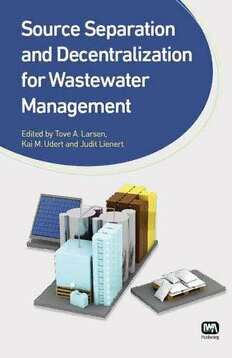Table Of ContentSource Separation and
Decentralization for
Wastewater Management
Source Separation and
Decentralization for
Wastewater Management
Tove A. Larsen, Kai M. Udert
and Judit Lienert
Publishedby IWAPublishing
AllianceHouse
12CaxtonStreet
LondonSW1H0QS,UK
Telephone:+44(0)2076545500
Fax:+44(0)2076545555
Email:[email protected]
Web:www.iwapublishing.com
Firstpublished2013
©2013IWAPublishing
Cover Image: New technologies for the treatment of source-separated waste streams will
improvetherecoveryofresourcessuchasnutrientsandwater.CopyrightEOOSDesign.
Apartfromanyfairdealingforthepurposesofresearchorprivatestudy,orcriticismorreview,as
permittedundertheUKCopyright,DesignsandPatentsAct(1998),nopartofthispublication
may be reproduced, stored or transmitted in any form or by any means, without the prior
permission in writing of the publisher, or, in the case of photographic reproduction, in
accordancewiththetermsoflicensesissuedbytheCopyrightLicensingAgencyintheUK,or
in accordance with the terms of licenses issued by the appropriate reproduction rights
organizationoutsidetheUK.Enquiriesconcerningreproductionoutsidethetermsstatedhere
shouldbesenttoIWAPublishingattheaddressprintedabove.
The publisher makes no representation, express or implied, with regard to the accuracy of
theinformationcontainedinthisbookandcannotacceptanylegalresponsibilityorliabilityfor
errorsoromissionsthatmaybemade.
Disclaimer
Theinformationprovidedandtheopinionsgiveninthispublicationarenotnecessarilythoseof
IWAandshouldnotbeacteduponwithoutindependentconsiderationandprofessionaladvice.
IWAandtheAuthorwillnotacceptresponsibilityforanylossordamagesufferedbyanyperson
actingorrefrainingfromactinguponanymaterialcontainedinthispublication.
BritishLibraryCataloguinginPublicationData
ACIPcataloguerecordforthisbookisavailablefromtheBritishLibrary
ISBN9781843393481(Paperback)
ISBN9781780401072(eBook)
Contents
Authors’ list ............................................. xxi
Preface ................................................ xxxi
WilliGujer
Chapter 1 ................................................. 1
Editorial
ToveA.Larsen,KaiM.UdertandJuditLienert
Part I: The advantages of source separation and
decentralization .......................................... 11
Chapter 2
The energy issue in urban water management ............ 13
BruceE.Rittmann
2.1 Introduction–ThinkGloballyandActLocally ................. 13
2.2 GlobalEnergyGoal ....................................... 14
2.3 RenewableEnergySources ............................... 15
2.4 Photosynthesis,Biomass,andBOD ........................ 15
2.5 MicrobialEnergyConversion .............................. 16
2.6 NutrientRecovery ........................................ 20
2.7 NewBiomassfromPhotosyntheticMicroorganisms ........... 21
2.8 LowerEnergyUse ........................................ 23
2.9 TheImpactofSourceSeparationand
Decentralization .......................................... 24
References .................................................. 25
vi SourceSeparationandDecentralization
Chapter 3
Peak phosphorus and the role of P recovery in
achieving food security .................................. 29
DanaCordell
3.1 Introduction .............................................. 29
3.2 PhosphorusandGlobalFoodSecurity ...................... 29
3.3 GlobalPhosphorusScarcityandPollution ................... 30
3.4 FiveDimensionsofPhosphorusScarcity .................... 32
3.5 PhosphorusUseintheGlobalFoodSystem ................. 36
3.6 AchievingPhosphorusSecurity ............................ 38
3.6.1 Anintegratedapproachisrequired ................... 39
3.6.2 Theroleofdecentralizedsanitationsystems ........... 40
3.6.3 Keychallengesandopportunities .................... 40
3.7 Conclusions ............................................. 41
References .................................................. 42
Chapter 4
Nitrogen economy of the 21st Century .................... 45
JanWillemErismanandToveA.Larsen
4.1 Introduction .............................................. 45
4.2 NitrogenSources ......................................... 46
4.3 ReleaseofNitrogentotheEnvironment ..................... 47
4.4 EnvironmentalConsequences ............................. 51
4.5 TheFutureandPossibleInterventions ...................... 53
4.6 Conclusions ............................................. 55
References .................................................. 56
Chapter 5
Urban water supply under expanding water
scarcity ................................................. 59
MalinFalkenmarkandJunXia
5.1 Introduction .............................................. 59
5.2 WaterSupplyofUrbanAreas .............................. 59
5.2.1 Onthevergeofanewwaterscarcity ................. 61
5.3 ImplicationsofIncreasingCompetition? ..................... 62
5.4 AdaptingtoIncreasingWaterShortage ...................... 63
5.5 ReasonableBlue-WaterAllocation .......................... 65
5.6 IrrigationPotential ........................................ 67
5.7 AdditiveVersusCompetingWaterUses ..................... 68
5.8 Conclusion .............................................. 68
Contents vii
Acknowledgement ............................................ 69
References .................................................. 69
Chapter 6
The issue of micropollutants in urban water
management ............................................ 71
KlausKümmerer
6.1 Introduction .............................................. 71
6.2 ParentCompounds,MetabolitesandTransformation
Products ................................................ 72
6.3 Classification ............................................ 73
6.4 SomeExamplesofMicropollutants ......................... 73
6.4.1 Flameretardants .................................. 74
6.4.2 Biocidesandpesticides ............................. 74
6.4.3 Endocrinedisruptingchemicals ...................... 75
6.4.4 Anti-corrosiveadditives ............................. 76
6.4.5 Personalcareproducts ............................. 76
6.4.6 Perfluorinatedsurfactants–PFOS
andPFOA ........................................ 76
6.4.7 Pharmaceuticals ................................... 76
6.4.8 Artificialsweeteners ................................ 77
6.4.9 Engineerednanoparticles ........................... 77
6.5 ManagementOptions ..................................... 78
6.5.1 Technology ....................................... 78
6.5.2 Educationandtraining .............................. 78
6.5.3 Sourceseparation ................................. 79
6.5.4 Benignbydesign .................................. 81
References .................................................. 83
Chapter 7
Full costs, (dis-)economies of scale and the
price of uncertainty ...................................... 85
MaxMaurer
7.1 Introduction .............................................. 85
7.2 Conveyance-BasedWastewaterTreatment .................. 86
7.3 (dis-)EconomiesofScale .................................. 88
7.4 DeficitsoftheNetPresentValueMethod .................... 90
7.5 TheCostofUncertainty ................................... 92
7.6 On-SiteTreatmentSystems ............................... 94
7.7 Conclusions ............................................. 97
References .................................................. 98
viii SourceSeparationandDecentralization
Chapter 8
The rationale for decentralization of wastewater
infrastructure ........................................... 101
GeorgeTchobanoglousandHaroldLeverenz
8.1 TypesofWastewaterInfrastructure ........................ 101
8.2 CentralizedTreatmentSystems ........................... 102
8.3 DistributedCentralizedSystems ........................... 102
8.4 CentralizedSystemswithSatellites ........................ 104
8.4.1 Implementationofsatellitesystems .................. 108
8.5 DecentralizedSystems ................................... 108
8.5.1 Typesofdecentralizedwastewatersystems .......... 108
8.5.2 Historicaldevelopmentofdecentralizedsystems ...... 109
8.5.3 Moderndevelopmentofdecentralizedsystems ....... 109
8.5.4 Advantagesanddisadvantagesof
decentralization ................................... 110
8.5.5 Continueddevelopmentsindecentralizedsystems .... 111
8.5.6 Futureevolutionofdecentralizedwastewater
systems ......................................... 111
8.6 TheFuture ............................................. 112
8.7 Summary .............................................. 114
References ................................................. 115
Chapter 9
Cities of the global South–is decentralized sanitation
a solution? ............................................. 117
BarbaraEvans
9.1 Introduction ............................................. 117
9.2 CentralizedSystems ..................................... 119
9.3 Unbundling ............................................. 121
9.3.1 Thevaluechain .................................. 121
9.3.2 Verticalunbundling ................................ 122
9.3.3 Horizontalunbundling ............................. 123
9.4 Decentralization ......................................... 124
9.5 Technologies ........................................... 124
9.6 CreatingIncentives ...................................... 127
9.6.1 Contractualincentives ............................. 127
9.6.2 Financialincentives ............................... 128
9.6.3 Politicalincentives ................................ 128
9.6.4 Professionalincentives ............................ 129
9.7 Summary .............................................. 129
References ................................................. 131
Contents ix
Part II: The challenges of source separation and
decentralization ......................................... 133
Chapter 10
Implementation of source separation and decentralization
in cities ................................................. 135
ToveA.LarsenandWilliGujer
10.1 Introduction ........................................... 135
10.2 TheMainAdvantagesofSourceSeparationand
DecentralizationinCities ................................ 137
10.3 ChallengesofSourceSeparationandDecentralization
inCities ............................................... 138
10.3.1 Thechallengeoftransport ....................... 139
10.3.2 Thechallengeofdevelopingtreatment
processes ..................................... 141
10.4 Transition ............................................. 146
10.5 Conclusions ........................................... 148
References ................................................. 148
Chapter 11
Hygiene, a major challenge for source separation and
decentralization ......................................... 151
ThorAxelStenström
11.1 Introduction ............................................ 151
11.2 HazardIdentificationinaSystemPerspective .............. 153
11.3 HumanExposureAssessment ........................... 155
11.4 TreatmentBarriersandExamplesofTheir
ReductionEfficiency .................................... 156
11.5 QuantificationsofRisksandRisk-BenefitStrategies ......... 158
11.6 FutureChallengesandKnowledgeGaps .................. 159
References ................................................. 159
Chapter 12
Closing the loop: Recycling nutrients to
agriculture .............................................. 163
HåkanJönssonandBjörnVinnerås
12.1 NutrientBalanceClosetoCropRemoval .................. 163
12.2 Source-SeparatedToiletWastesare
UniqueBiologicalFertilizers ............................. 167
12.3 NutrientRequirementsandFertilizersUsedinPractice ...... 167

